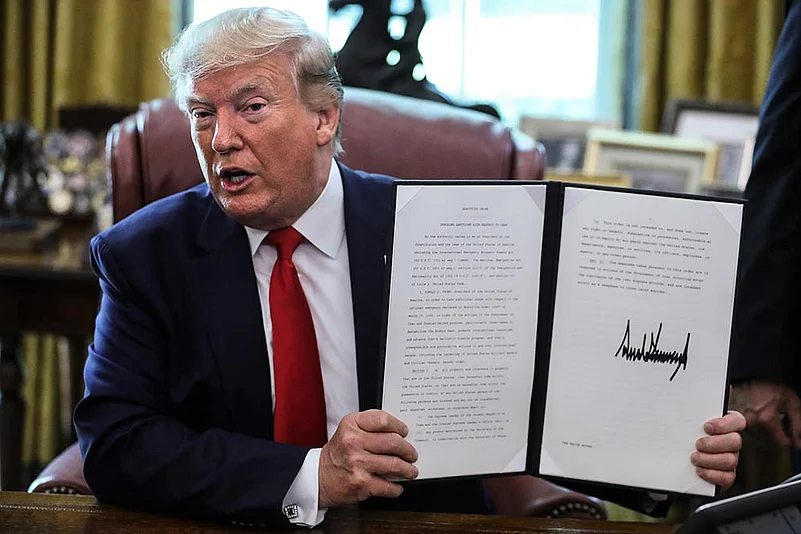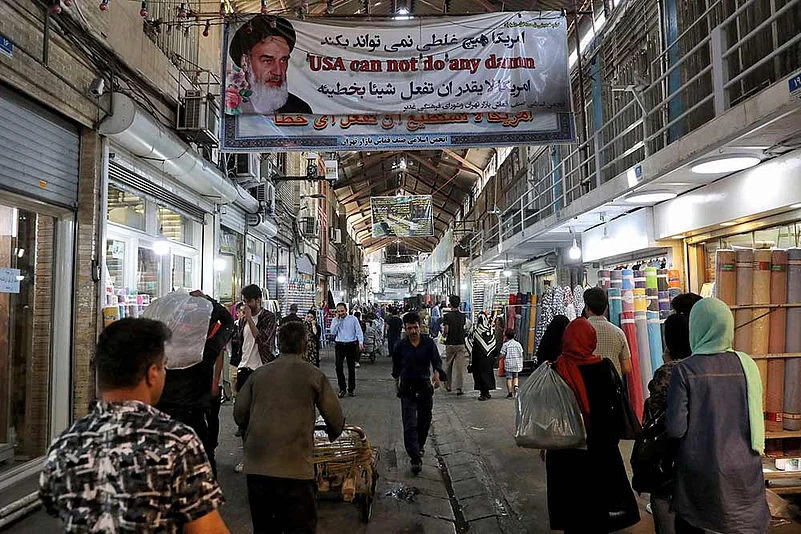That the current US administration has no use for volumes of history is another matter, but past experience shows imposing ‘crippling sanctions’ to force adversarial nations to fall in line has seldom worked for American presidents. Armed interventions, too, send out dire warnings across the years. Afghanistan and Iraq are two notable examples, where strong-arm tactics had backfired devastatingly, effects of which blight the region still.
As US President Donald Trump and his team of hawkish advisors ratchet up war rhetoric on Iran after the downing of an US surveillance drone by the Iranian Revolutionary Guard Corps—an incident preceded by attacks on several oil tankers from unidentified sources in the Persian Gulf—policy planners across the world are watching the developments with trepidation and a touch of scepticism.
More than one-fifth of the world’s oil passes through the Straits of Hormuz—the 39 km-wide choke point that passes from the Persian Gulf to the Straits of Oman on to the Indian Ocean—making the region’s stability and security a global issue. The current turmoil has already started affecting oil prices, pushing it up to $65 dollars a barrel. The fear is, it could rise further and growing tension could affect the uninterrupted supply of oil.
The Trump administration has put Iran under sanctions (top Iranian military and civilian leaders were also specifically targeted by sanctions after the drone incident) and used its economic clout with other countries to stop them from buying Iranian oil to choke Tehran. India is one of the eight countries that have been prevented from buying oil from Iran—New Delhi’s third largest supplier.
India could be one of the worst affected countries if the situation deteriorates—the Gulf is its major source for oil and home to over seven million Indians. The annual remittance they send helps in paying a substantial part of the country’s oil bill; it contributes to the livelihood and welfare of millions of Indian families.
For India, it is crucial to have good relations with Iran. Their engagement goes beyond energy, as they cooperate on the Chabahar port that allows India access to Afghanistan and Central Asia. Moreover, if Delhi moves away from Tehran, it allows the latter to iron out its differences with Pakistan and build a stronger relation—something not in India’s interest.
“The ongoing uncertainty has already started adding pressure on the price of oil. Any deterioration will make the situation worse for us,” says former Indian diplomat Navtej Sarna, who was India’s ambassador to both Iran and the US.
US secretary of State Mike Pompeo, one of Trump’s close advisors on Iran spent June 26 in New Delhi, meeting his Indian counterpart S. Jaishankar, before calling on PM Narendra Modi. The two sides discussed bilateral, regional and some of the looming global challenges. Presumably, it also allowed some clarity on Iran.
A possible Trump-Modi meeting on the sidelines of the G20 Summit in Tokyo at the end of June is being worked out that would allow the two leaders to reaffirm their commitment to further strengthen India-US relations.
Former diplomat Talmiz Ahmad feels that India should forcibly make its position known to the US. “India is a strong country and it is about time it comes out of the American yoke and tell it clearly how its policy in the Persian Gulf was damaging Indian interest,” he says.
The nub of the problem is over the 2015 nuclear agreement that Iran had signed with the US and other Western nations. Formally known as the Joint Comprehensive Plan of Action (JCPOA), it put Iran’s nuclear facilities under international scrutiny and addressed widespread concerns about an Iranian nuclear bomb. In exchange, the agreement assured the lifting of US and other sanctions on Iran, allowing it to resume trade and commerce to strengthen its ailing economy.

But Trump, who had rubbished the agreement as the ‘worst deal’ even during his presidential election campaign, withdrew from the JCPOA that his predecessor Barack Obama had signed on in May 2018. The situation, however, worsened further from May 8, 2019, the first anniversary of the US withdrawal from the Plan of Action, when Trump decided to reimpose sanctions on Iran. Soon after, four oil tankers (including two Saudi ships) were attacked in the Gulf of Oman by unidentified sources that the US and its allies suspected to be Iranian ‘proxies’. Reacting to it, the Trump administration announced the movement of USS Arlington—that transports US marines, vehicles and other military hardware (helping in amphibious assaults)—and a Patriot battery to the area along with 1,000 troops. This is in addition to the 15,000 soldiers stationed in West Asia in the Central Command (CENTCOM) that looks after US interests in the Gulf.
But tension reached fever pitch last week when the US drone was shot down by Iranian forces. A US airstrike was on the cards, but Trump apparently pulled back at the last minute as it could have killed around 150 people, deemed by him to be “not proportionate” to the attack on the unmanned drone. Trump also added defiantly that he was “in no hurry” to confront Iran.
Independent sources, however, say the drone was downed after several warnings and on entering Iranian airspace. Iran claims that an US Navy aircraft with a crew of 35 and flying close to the drone was not targeted. Though these actions might suggest that neither the US nor Iran wants a conflict, the situation in the Gulf remains uncertain.
Opinion is divided on the restraint shown by the US. “The downing of the sophisticated US drone showed that despite years of isolation, the Iranian army is extremely capable. , in an armed confrontation it will be no pushover,” says Ahmad. He feels that Trump was averse to getting into a fresh West Asia conflict, especially since he had promised voters to get US troops back from Afghanistan and Iraq.
Historian Srinath Raghavan does not rule out the possibility of a forthcoming phase of instability and violence in the Persian Gulf. “The developments have only strengthened hardliners in Iran, who were all along sceptical of any agreement with the Americans.”
Moreover, Trump’s close aides and allies like Israel, Saudi Arabia and the UAE could egg him on to opt for the military option. Yet Iran, which had been under US sanctions since 1979, is as tough a cookie as obtains under the circumstances—it has not crumbled despite pressure and has shown immense resilience to fight back.
Raghavan does not rule out the possibility of a phase of “tanker-wars” in the region, as in the 1980s during the Iran-Iraq war. It may not erupt into a full-fledged war, but armed scuffles targeting each other’s assets are a possibility. “The biggest casualty of recent developments is the absence of trust among the contenders,” says Raghavan. “Even if they eventually negotiate, would they be able to trust each other for a future deal to work?”
It’s a question of vital importance—the JCPOA took back-breaking work before being finalised; US suspicion undid all of that. A bedrock of trust has to be laid before restoring peace in the Persian Gulf.















